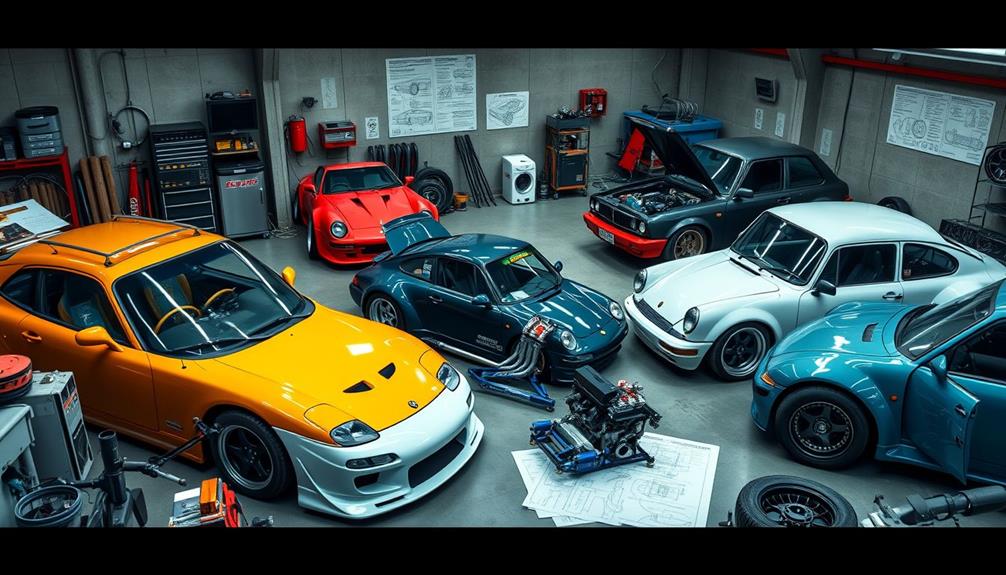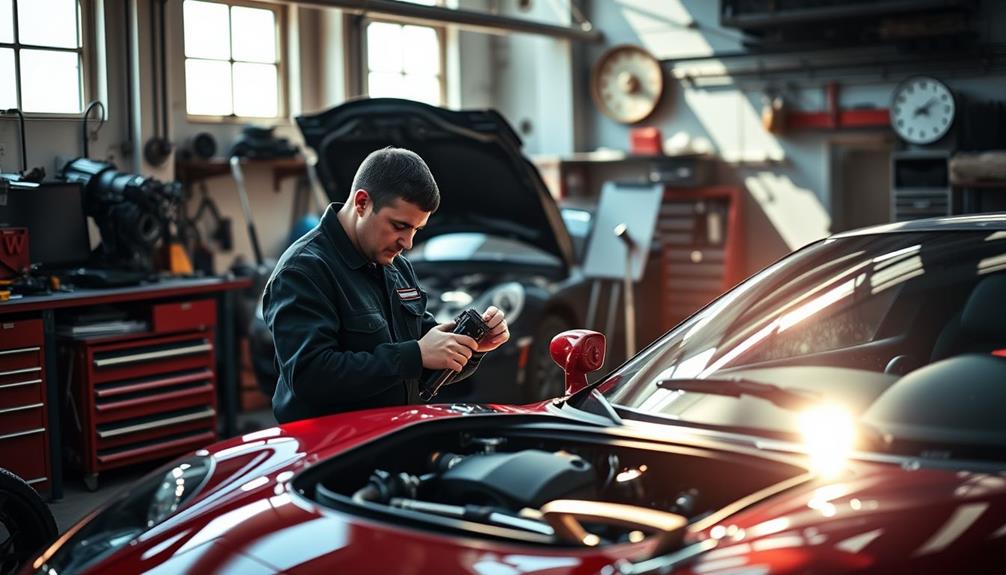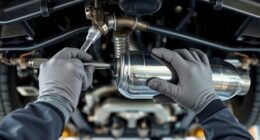Car tuning stages define the levels of modifications that boost your vehicle's performance. Stage 1 is your entry point, focusing on basic upgrades like ECU remapping and enhanced air intake, yielding about 20 bhp. Stage 2 ramps it up with more extensive changes, such as high-flow exhaust systems and intercoolers, offering gains between 40 to 100 horsepower. Finally, Stage 3 involves major engine overhauls and upgraded components, requiring higher maintenance but delivering maximum power. Choosing the right stage depends on your performance goals and budget. Keep exploring to discover the essential details for each tuning level and what they entail.
Key Takeaways
- Car tuning is categorized into three stages, each providing varying levels of performance enhancements.
- Stage 1 includes basic modifications like ECU remapping and performance air filters, offering about 20 bhp gains.
- Stage 2 involves more extensive upgrades such as high-flow exhausts and intercoolers, yielding 40 to 100 horsepower increases.
- Stage 3 focuses on significant engine modifications and specialized maintenance, aiming for maximum performance with up to 100 bhp gains.
- Regular maintenance and monitoring are crucial for tuned cars to ensure reliability and optimal performance.
Overview of Car Tuning Stages
When it comes to car tuning stages, you'll find a structured approach designed to boost your vehicle's performance. These stages range from basic modifications to thorough enhancements, allowing you to tailor your car to your specific needs.
Stage 1 tuning is your entry point, involving straightforward upgrades like ECU remapping and improvements to the air intake and exhaust system. It focuses on enhancing performance without major hardware changes, making it a great choice if you're new to car tuning.
As you progress to stage 2 tuning, you'll explore more detailed modifications. This stage often entails replacing exhaust components and implementing aggressive ECU remapping, which helps increase airflow and remove performance limitations. You'll enjoy noticeable gains in power and efficiency here.
For serious enthusiasts, stage 3 tuning takes things to the next level. It requires significant engine modifications, such as upgraded camshafts and turbochargers, leading to substantial power boosts.
However, keep in mind that this stage can also lead to higher costs and maintenance needs.
Understanding these tuning stages will help you make informed decisions about the performance parts that best suit your goals.
Understanding Stage 1 Tuning

When you think about Stage 1 tuning, it's all about straightforward modifications that boost your car's performance.
By upgrading components like the air filter and exhaust, plus remapping the ECU, you can enjoy significant power gains.
This stage sets the groundwork for future enhancements without overwhelming you with complicated changes.
Basic Modifications Overview
Enhancing your vehicle's performance through Stage 1 tuning offers an exciting opportunity for car enthusiasts. This tuning stage focuses on basic modifications that greatly boost your engine's efficiency without major alterations to stock parts. Key upgrades include performance air filters and an upgraded exhaust system, which contribute to better airflow and, ultimately, power gains.
Installing an induction kit can improve your car's air intake, while a sports exhaust system enhances exhaust flow, resulting in noticeable improvements in horsepower and throttle response. Typically, you can expect around 20 bhp in power gains from these modifications, making Stage 1 an ideal first step for anyone looking to elevate their driving experience.
One of the advantages of Stage 1 tuning is that it often retains the original catalytic converter, ensuring you stay compliant with emissions regulations. By combining ECU remapping with these basic tuning parts, you can maximize performance gains and even improve fuel economy.
ECU Remapping Benefits
Stage 1 tuning wouldn't be complete without considering the benefits of ECU remapping, which plays a vital role in optimizing your car's performance. By modifying the software of the engine control unit, ECU remapping fine-tunes important parameters like fuel mixture, ignition timing, and turbo boost. This leads to noticeable enhancements in power levels, often yielding gains of 10-20%, depending on your vehicle model and its current engine condition.
One of the key advantages of ECU remapping is the improved throttle response and overall drivability. You'll find that your car feels more engaging and responsive, making driving a more enjoyable experience.
Additionally, many remaps can be performed quickly through the OBD-II port using specialized tuning software, making it accessible for car enthusiasts.
However, it's important to remember that regular maintenance and monitoring of engine parameters post-remap are necessary. Doing so will guarantee long-term reliability and help prevent potential engine damage.
With the right approach, ECU remapping can be a significant upgrade in your Stage 1 tuning journey, revealing your vehicle's full potential while enhancing your driving pleasure.
Performance Gains Explained
Understanding the performance gains from Stage 1 tuning involves recognizing how simple modifications can greatly elevate your driving experience. At this foundational level, you can expect improvements primarily from ECU remapping, which typically boosts horsepower by around 20 bhp. This enhancement not only increases power but also improves throttle response, making your car feel more responsive and agile.
Common upgrades in Stage 1 tuning include replacing the air filter and upgrading the exhaust system. These changes don't require altering stock parts, allowing for noticeable performance boosts without extensive modifications.
By combining ECU remapping with additional upgrades like induction kits and sports exhausts, you'll experience even greater gains in power output and fuel economy.
While Stage 1 tuning may shift the power band rather than deliver massive increases in overall power, it serves as an excellent starting point for car enthusiasts. The improvements you achieve here can set the stage for future modifications, ensuring your vehicle remains a thrilling ride.
Embrace Stage 1 tuning, and get ready to enjoy a more dynamic driving experience!
Key Upgrades for Stage 1
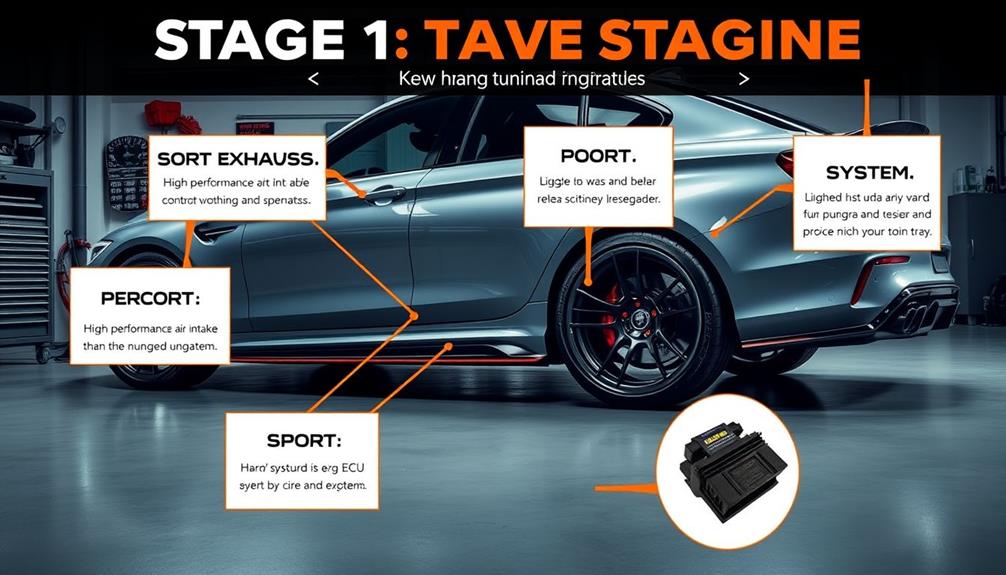
When you immerse yourself in Stage 1 tuning, you'll quickly discover that key upgrades can greatly enhance your vehicle's performance without major overhauls. One of the most effective upgrades is a performance air filter. This simple addition improves airflow into the engine, boosting power and efficiency. By optimizing the air intake, you can see noticeable gains in horsepower.
Another essential upgrade is a cat-back exhaust system. This replacement enhances exhaust flow, allowing your engine to breathe better and expelling gases more efficiently. You'll likely experience an increase in torque and horsepower, with gains typically ranging from 10% to 20%.
Plus, since you retain the original catalytic converter, you'll stay compliant with emissions regulations—a significant bonus.
Stage 1 mods are designed as standalone changes, meaning you won't need to worry about extensive modifications. With these upgrades, you can enjoy a more exhilarating driving experience while keeping your vehicle's original components intact.
Embrace the power of Stage 1 tuning and feel the difference in performance as you hit the road!
Exploring Stage 2 Modifications

As you immerse yourself in Stage 2 modifications, you'll notice that the focus shifts to more extensive upgrades designed to maximize your vehicle's performance.
Stage 2 tuning typically involves replacing restrictive exhaust components, including high-flow exhaust systems and sports catalysts. These enhancements considerably improve exhaust flow and reduce back pressure, allowing your engine to breathe better.
One of the fundamental upgrades in Stage 2 is the performance intercooler. This component is essential for improving airflow and lowering intake temperatures, which guarantees peak turbocharger performance and overall engine efficiency.
To fully leverage these modifications, ECU remapping becomes necessary. This process adjusts fuel delivery, timing, and boost pressure to match the increased airflow from your upgrades.
You can expect considerable power gains from Stage 2 tuning, often ranging between 40 to 100 horsepower, depending on your vehicle and specific enhancements.
Additionally, incorporating high-flow fuel injectors and upgraded air intakes is critical to prevent issues like turbo choking and to maintain engine reliability under higher performance demands.
With these modifications, you're well on your way to achieving a thrilling driving experience.
Essential Components for Stage 2
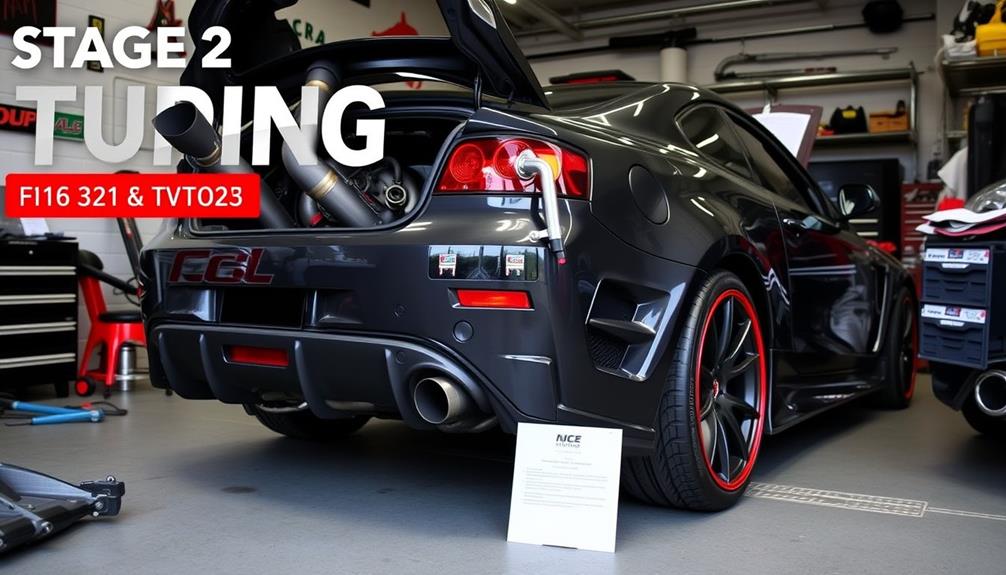
To maximize the benefits of Stage 2 modifications, specific components are vital for achieving ideal performance.
First and foremost, you'll need a high-flow exhaust system. This upgrade enhances gas flow and reduces back pressure, significant for improving engine performance.
Next, consider upgrading your intake system with a performance air filter. This helps facilitate better airflow and minimizes turbo lag, guaranteeing your engine breathes efficiently.
An intercooler upgrade is also important. It maintains peak air temperatures, improving air density and overall engine efficiency during those higher performance demands.
Once you've addressed airflow, ECU remapping becomes essential for Stage 2 tuning. This process calibrates your engine's fuel and timing settings to match the new hardware, often resulting in power gains of 40 bhp or more.
To support these modifications, larger fuel injectors and a high-flow fuel pump are necessary. They ensure adequate fuel delivery to match the increased air intake and exhaust flow.
Advanced Features of Stage 3
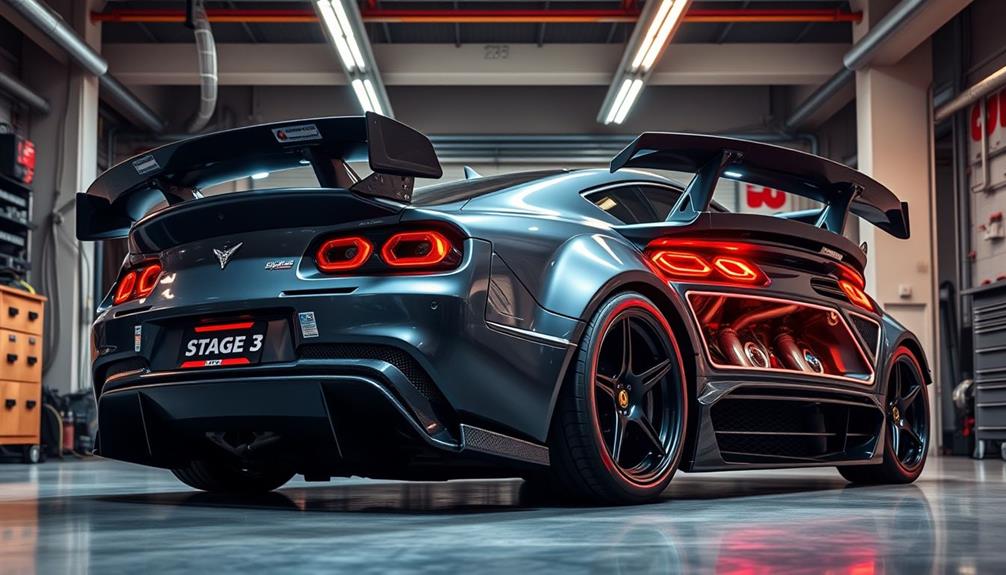
Elevating your vehicle to Stage 3 tuning reveals a world of advanced features designed for serious performance enhancements. At this level, your engine needs extensive upgrades to internal components. You'll be looking at high-performance camshafts, pistons, and connecting rods, all engineered to handle significant power gains—sometimes exceeding 100 horsepower.
To manage the added torque, you'll need a high-performance clutch and transmission. This guarantees that you maintain drivability, even when your engine's output is maximized. Additionally, with the increased strain on your engine, upgraded cooling systems become essential. Expect to install enhanced radiators and intercoolers to prevent overheating.
| Feature | Description | Benefits |
|---|---|---|
| High-Performance Camshafts | Upgraded camshafts for peak airflow | Improved engine efficiency |
| Enhanced Clutch & Transmission | Upgraded components to handle increased torque | Better power delivery |
| Upgraded Radiators | Improved cooling systems | Reduced risk of overheating |
| High-Performance Pistons | Stronger pistons for higher pressure | Increased power potential |
With these modifications, your vehicle will perform at an extraordinary level, but keep in mind that Stage 3 tuned vehicles often require specialized maintenance.
Supporting Mods for Higher Stages

Achieving higher tuning stages demands more than just powerful engine upgrades; supporting mods play an important role in maximizing your vehicle's performance. Car tuning challenges also involve improving the handling, braking, and overall stability of the vehicle. Upgrading suspension components, brakes, and tires are crucial for achieving higher tuning stages. Additionally, proper tuning and calibration of the engine and other performance parts are essential to ensure everything works together seamlessly. Overall, car tuning challenges require a comprehensive approach that addresses all aspects of the vehicle’s performance.
As you increase power and torque, it's critical to make sure your car can handle these enhancements effectively. Upgraded brakes are essential for maintaining stopping power, especially during aggressive driving, reducing the risk of brake fade when you push your limits.
High-quality tires are another key supporting mod. They improve grip and handling, which is important as torque increases, helping you maintain traction during acceleration and cornering.
Additionally, a stronger clutch becomes necessary for Stage 2 and above to prevent slippage under the added torque from your performance modifications.
Don't overlook enhanced suspension components, either. Upgraded shocks and springs are significant for maintaining stability and control, making sure of better road contact during high-speed maneuvers.
Without these supporting mods, your car may struggle to harness its full potential, ultimately limiting your enjoyment and safety on the road.
Investing in these enhancements won't only elevate your vehicle's performance but also provide a more thrilling driving experience.
Maintenance Considerations for Tuned Cars

When you tune your car, sticking to a regular maintenance schedule is essential for keeping it running smoothly.
You'll also need to keep a close eye on engine temperatures, as higher performance can lead to overheating.
Neglecting these aspects can result in costly damage, so stay proactive to guarantee your ride remains in top shape.
Regular Maintenance Schedule
Regular maintenance is essential for keeping your tuned car performing at its best and preventing costly engine damage. Since performance mods often push your vehicle beyond standard limits, you need to adjust your maintenance schedules accordingly.
Oil changes should occur more frequently than usual—aim for every 3,000 to 5,000 miles—to keep your engine healthy under increased strain.
Additionally, be proactive about inspecting upgraded parts like brakes and suspension. Regular checks will guarantee they can handle the heightened demands associated with your car's enhanced performance.
Don't overlook other critical components; increased power levels often mean your fuel injectors, turbochargers, and intercoolers should be inspected more frequently to avoid potential failures.
Maintaining a detailed log for your maintenance schedules can help you track these adjustments and keep your vehicle in top shape.
Remember, consistent care can make a significant difference in longevity and performance. Neglecting regular maintenance not only risks engine damage but can also lead to costly repairs down the road.
Monitoring Engine Temperatures
Keeping an eye on engine temperatures is vital for maximizing the performance and longevity of your tuned car. Higher power outputs can lead to increased thermal stress, which might cause engine damage if not managed properly.
Regular monitoring of engine temperatures is essential, especially after engine remapping, as it often raises fuel delivery and combustion temperatures.
To effectively manage engine temperatures, consider the following:
- Use aftermarket gauges or OBD-II scanners for real-time temperature monitoring.
- Install upgraded cooling systems, like larger radiators, intercoolers, and oil coolers, to maintain ideal temperatures during performance driving conditions.
- Perform frequent maintenance inspections, checking coolant levels and thermostat functionality to guarantee your cooling system operates effectively.
- Keep temperatures within safe ranges, typically between 190°F and 230°F (88°C to 110°C), to prevent knock and pre-ignition issues.
Choosing the Right Stage for You

Choosing the right tuning stage for your vehicle hinges on a few key factors that align with your personal goals and budget. Start by clearly defining your performance goals. If you're aiming for modest improvements, Stage 1 is a great entry point. However, if you're seeking significant power gains, consider Stage 2 or 3.
Next, assess your budget. Stage 1 modifications are generally more affordable, while Stages 2 and 3 require a larger financial commitment due to extensive parts and labor. Finally, evaluate your vehicle's compatibility with potential upgrades. Some cars perform better with specific tuning stages based on their engine type and capabilities.
Here's a quick overview to help you decide:
| Tuning Stage | Performance Gains |
|---|---|
| Stage 1 | +20 bhp |
| Stage 2 | +40 bhp |
| Stage 3 | +100 bhp |
| Cost | Low to Medium |
| Vehicle Compatibility | Varies by Engine Type |
Research and consult with experienced tuners to understand how each stage affects reliability and maintenance. Align your choice with realistic expectations for best results.
Frequently Asked Questions
What Is Stage 1, Stage 2, Stage 3 Tuning?
Stage 1 tuning boosts your car's performance with simple tweaks like ECU remapping and better filters. Stage 2 adds more power through upgrades like intercoolers, while Stage 3 demands serious modifications for maximum horsepower gains.
What Are the Stages in Car Modification?
When you modify a car, you typically start with basic enhancements like ECU remapping. As you progress, you can add more complex upgrades, eventually leading to extensive engine modifications for significant power gains and performance improvements.
What Is a Stage 4 Car Tune?
Think of a Stage 4 car tune as releasing a wild stallion. It's the pinnacle of tuning, involving engine rebuilds, top-tier components, and extensive upgrades. Just remember, this beast isn't meant for daily rides.
What Is a Stage 5 Tune?
A Stage 5 tune involves extreme modifications, requiring a complete engine rebuild and high-performance parts. You'll get significant power boosts, but it's costly and typically unsuitable for daily driving, focusing on track performance instead.
Conclusion
To sum up, choosing the right tuning stage for your car can greatly enhance your driving experience. For example, if you start with a Stage 1 tune on a VW Golf GTI, you might see a boost from 220 to 250 horsepower, making daily drives more exhilarating. Just remember, as you consider higher stages, factor in the necessary supporting mods and maintenance to keep your ride running smoothly. Happy tuning!

